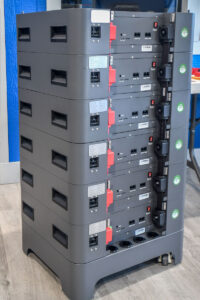Lithium Battery Stacking
Solar energy means sustainable energy, but it can only generate power when the sun is shining. To bridge the gap between daytime solar production and evening energy use, homes and businesses need a way to store that power.
Rubix Battery designs stackable lithium battery systems that convert solar energy into a reliable and continuous power source. Let’s look at how lithium battery stacking is reshaping solar storage with Rubix Battery leading the way.
What is lithium battery stacking?
 Lithium battery stacking refers to connecting multiple battery modules in series, in parallel, or both to achieve the required system voltage and capacity. For solar installations, this flexibility is essential. Whether you are beginning with a small residential array or developing a commercial microgrid, a stackable architecture allows storage to grow with your system. Rather than replacing existing equipment, you can expand incrementally. This preserves your investment while improving energy independence.
Lithium battery stacking refers to connecting multiple battery modules in series, in parallel, or both to achieve the required system voltage and capacity. For solar installations, this flexibility is essential. Whether you are beginning with a small residential array or developing a commercial microgrid, a stackable architecture allows storage to grow with your system. Rather than replacing existing equipment, you can expand incrementally. This preserves your investment while improving energy independence.
What are benefits of lithium battery stacking?
Lithium battery stacking gives you the flexibility to grow your energy storage system as your needs change. Instead of committing to an oversized setup upfront or replacing components later, you can simply add modules over time. This modular approach keeps costs manageable and ensures your system evolves alongside your solar array or energy demands.
Stacking batteries allows you to make the most of every kilowatt your solar panels generate. Instead of sending excess energy back to the grid or letting it go unused, you can store it for when you need it most. This approach reduces grid reliance. You’ll also see it reflected in your bottom line.
The difference between series stacking and parallel stacking
Configuring modules in series raises the system’s operating voltage, which often improves inverter efficiency and reduces current-related losses. This is ideal for hybrid inverter systems or DC-coupled designs. However, series arrangements demand precise cell balancing and robust protective measures to maintain long-term stability.
Parallel configurations expand available amp-hours, increasing runtime and supporting higher load demand. While conceptually more straightforward, they require uniform module health and firmware consistency to avoid imbalance. Rubix Battery modules are engineered for both configurations, ensuring predictable behavior and seamless integration with photovoltaic (PV) hardware.
Other design elements to consider when stacking lithium batteries
Solar-connected storage experiences high daily cycling and rapid charge-rate fluctuations due to weather variability. Effective thermal and structural design is critical to maintain performance and extend life. Rubix Battery stacks utilize reinforced frames, optimized compression systems, and efficient thermal conduction strategies to ensure stability across diverse installation environments, ranging from rooftop arrays to containerized energy storage systems.
Reliable storage depends on more than quality cells; it requires intelligent control. Every Rubix Battery stack incorporates an advanced Battery Management System (BMS) that continuously monitors voltage, temperature, and state of charge at the module level. This enables safe charging from PV sources with precise load control, active cell balancing, and real-time data visibility for integration with energy management platforms. The result is greater operational confidence and optimized lifecycle performance.
Planning a solar-plus-storage system? Rubix Battery delivers scalable, serviceable, and technically robust solutions built to meet the demands of modern energy projects. Our LiFePO₄-based stackable solutions deliver the safety, scalability, and durability that solar applications demand. Whether you’re designing a residential backup system or a multi-megawatt solar-plus-storage installation, Rubix Battery provides a foundation for long-term energy independence.
Ready to build a smarter solar energy system? Contact us today.
